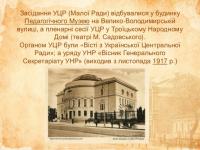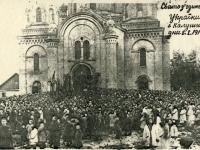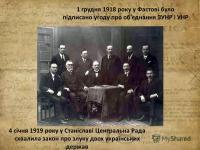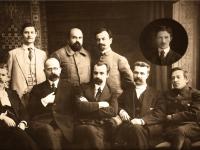On January 22, the day of the proclamation of the Act of Unification of the Ukrainian People's Republic and the Western Ukrainian People's Republic, Ukraine annually celebrates the Day of Unity. Officially, the holiday was established in Ukraine by the Decree of the President of Ukraine "On the Day of the Unification of Ukraine" of January 21, 1999, № 42/99.
The Act of Unification crowned the conciliar aspirations of Ukrainians in both parts of Ukraine - the Dnipro region and the Dnister region - at least from the middle of the 19th century. This was a fundamental event for Ukrainian statehood. On August 24, 1991, an extraordinary session of the Verkhovna Rada of the Ukrainian SSR adopted the Act of Independence of Ukraine. It was supported by Ukrainians in the All-Ukrainian referendum on December 1, 1991. This event became the starting point for the history of modern Ukrainian statehood. However, historians rightly point out that on August 24, 1991, Ukraine's state independence was actually restored.
For the first time in the XX century, Ukrainian independence was proclaimed on January 22, 1918, by the IV Universal of the Ukrainian Central Rada, and within a year (January 22, 1919) no less important event took place on Sofia Square in Kyiv - the unification of the Ukrainian People's Republic (hereinafter - UPR). and the Western Ukrainian People's Republic (hereinafter - WUPR) into one state. As a result of the failures of the Ukrainian Revolution of 1917–1921, statehood could not be preserved. And as a result, during the twentieth century, Ukrainians were forced to repeatedly restore it in the struggle.
Key messages
There are a number of meanings of the term "catholicity". The most common of these is the unification of all lands inhabited by a particular nation in a single territory; spiritual consolidation of all inhabitants of the state, unity of citizens, regardless of their nationality. Finally, catholicity is inseparable from the statehood, sovereignty, and real independence of the people - the foundation for building a democratic state. On the 71st anniversary of the Act of Reunification (January 22, 1990), one of the largest mass actions in Central and Eastern Europe took place in Ukraine - the "living chain" as a symbol of the unity of the eastern and western lands of Ukraine. More than a million people joined hands to create a continuous chain from Ivano-Frankivsk through Lviv to Kyiv. The action showed that Ukrainians have
overcome their fear of the Communist Party and are ready to oppose the totalitarian regime. 31 years ago, this event heralded the fall of the USSR and the restoration of independent Ukraine.
The idea of catholicity has always been a cornerstone and relevant for Ukrainians. From the second half of the 19th century, Ukrainian political unity became one of the leading motives for the declarations and activities of the national movement on both sides of Zbruch river. Unity presupposes not only the memory of the past but also the need for united joint work and interaction in modern Ukraine, when we, from different regions, communicate, work together, create significant and important things. The proclamation of the Unification of the Ukrainian People's Republic and the Western Ukrainian People's Republic on January 22, 1919, is a historic act of unification of Ukrainian lands in one state. The event is fundamental for Ukrainian statehood. The Act of Unification on January 22, 1919 crowned the conciliar aspirations of Ukrainians in both parts of Ukraine - the Dnipro region and the Dnister region - at least from the middle of the XIX century.
The idea of the unity of Ukraine was key for the next generation of participants in the Ukrainian liberation movement in the twentieth century. On January 22, we commemorate two equally significant events in Ukrainian history: the proclamation of the independence of the Ukrainian People's Republic and the Act of Unification of Ukrainian Lands. After all, on January 22, 1918, for the first time in the 20th century, Ukrainian independence was proclaimed by the Fourth Universal of the Ukrainian Central Rada, and within a year (January 22, 1919) no less important event took place on Sophia Square in Kyiv. National unity is not only a basic value for the country's citizens but also a prerequisite for successful resistance to external aggression. Today, Ukraine continues to fight for independence and unity. Therefore, catholicity remains on the agenda of national tasks. An integral Ukraine is the return of the occupied Crimea and certain districts of the Donetsk and Luhansk regions.
Historical background
The idea of unity for Ukrainians has always been relevant and basal. Confirmation of the understanding of the Ukrainian people of unity - regardless of the political borders that divided our territory - can be found in different eras. For example, "The Topographic Description of the Kharkiv Governorate", published in 1788, refers to the people living in three states: the Russian Empire (Left Bank and Slobozhanshchina), the Polish-Lithuanian Commonwealth (Right Bank), and the Habsburg Monarchy (Galicia, Bukovina, and Zakarpatia). "The Topographical Description" about Ukrainians says: “... When they gather for worship in Kyiv from the East near the Volga and the Don, from the West from Galicia and Lodomeria and
closer to Kyiv adjacent places, they look at each other not as foreigners, but as representatives of the only family… all these scattered compatriots still retain filial respect for the mother of their ancient lands of Kyiv.
The desire for the ideal of monolithic people, its unification in the conciliar state was inherent in various national movements in Europe. Textbook examples of this model are the unification of Germany and Italy in the 19th century. The Italians even introduced the concept of irredentism to describe the political program of unification of different peoples. The Ukrainian national movement came up with a program of irredentism during the "Spring of Nations" of 1848-1849, a series of revolutions that swept Europe from France to Wallachia. The first Ukrainian political organization, the Main Rus' Rada, which emerged in Lviv, took an active part in these events. In a manifesto of May 10, 1848, she declared: "We Rusyn Galicians belong to the great Rusyn's people, who speak one language and make 15 million, half a million people of which inhabit the land of Galicia." Among the surviving materials of the Main Russian Council is an anonymous article stating: "From the Tisza beyond the Carpathians, on both sides of the Dniester and the Dnieper to the banks of the Don, there are settlements of one Slavic people, numbering 15 million. That is why the purpose of such a great nation cannot be to take a side position in Europe, to submit to others. "
From the second half of the 19th century, Ukrainian political unity (unity) became one of the leading motives for declarations and the activities of the national movement on both sides of the Zbruch river. After 1865, in the version of the song to the words of Pavlo Chubynsky from Naddniprianshchyna and the music of Mykhailo Verbytsky from Galicia (it later became the basis of the anthem of Ukraine), the following words appeared: “Let us stand, brethren, in a bloody battle from Sian to Don, We will not let anyone rule in our native land." Founded in 1891 in Poltava, the secret student organization "Brotherhood of Tarasivtsi" proclaimed in the program: "Independent sovereign Ukraine: united and indivisible, from the Sian to the Kuban, from the Carpathians to the Caucasus." Later, Mykola Mikhnovsky used the slogan "One, the only, indivisible, free, independent Ukraine from the Carpathians to the Caucasus" in the pamphlet "Independent Ukraine" (1900).
In 1895, the Galician Julian Bachynsky in the book "Ukraina Irredenta" proclaimed: "Ukraine for yourself! That's her call. A free, large, politically independent Ukraine - one indivisible from the Sian to the Caucasus - that's its flag! " In practice, the idea of catholicity was expressed in the cooperation of Ukrainian citizens of different states. In the 1870s and 1890s, Mikhailo Drahomanov, Panteleimon Kulish, and Mikhail Hrushevsky came to work in Austria-Hungary from the Russian Empire. There they realized talents and gave an intellectual impetus to
the life of the Ukrainian community. In 1906, Mykhailo Hrushevsky wrote: "For the last twenty or twenty-five years, the Galician society has become accustomed to seeing and imagining Galicia as the spiritual and cultural center of the Ukrainian land, as the spiritual factory where Ukrainian culture is forged for the whole united Ukraine."
The First World War, the February Revolution of 1917, and the disintegration of Austria-Hungary in the fall of 1918 brought the ideal of catholicity closer. The meeting of soldiers of Ukrainian national formations was symbolic - not on the front of the First World War, where they were forced to kill each other, but in a solemn atmosphere in the homeland of the Cossacks - the island of Khortytsia in April 1918. The Galician Legion of Ukrainian Sich Riflemen, led by Archduke Wilhelm (Vasyl Vyshivany), came here with Austrian troops, and the Petro Bolbochan's Crimean group of the Zaporizhzhya Corps of Troops of the Ukrainian People's Republic, was on its way to Sivash. It is no coincidence that the names of both formations appealed to the traditions of the Zaporozhian Sich.
The process of unification of the two Ukrainian republics - the Ukrainian People's Republic and the Western Ukrainian People's Republic - began shortly after the establishment of Ukrainian rule in Eastern Galicia, and even before the UPR Directory triumphantly entered Kyiv. On December 1, 1918, at the railway station in Fastiv, representatives of the Western Ukrainian People's Republic and the Directory signed a "Pre-Accession Treaty" (ie, preliminary). The articles of the agreement stated the die-hard intention of the Western Ukrainian People's Republic to "merge as soon as possible into one great state with the Ukrainian People's Republic." For its part, the UPR declared that it agreed to "accept the entire territory and population of the Western Ukrainian People's Republic as an integral part of the state integrity of the Ukrainian People's Republic." The agreement was signed by Volodymyr Vynnychenko, Simon Petliura, Fedir Shvets, Panas Andrievsky from the Ukrainian People's Republic, and Longin Tsehelsky and Dmytro Levitsky from the Western Ukrainian People's Republic. The pre-accession treaty was ratified on January 3, 1919 at the first meeting of the Ukrainian National Council, the governing body of the Western Ukrainian People's Republic. A representative delegation headed by the Vice-President of the Ukrainian People's Republic Lev Bachynsky was sent to Kyiv to solemnly proclaim this Resolution and complete the legal registration of the unification of the two republics.
On January 22, 1919, on the first anniversary of the proclamation of the independence of the Ukrainian People's Republic, a solemn meeting was held on Sophia Square in Kyiv. They proclaimed the Universal of the Directory of the Ukrainian People's Republic on the union with the Western Ukrainian People's Republic. The festivities began with a speech by the head of the delegation of the Western Ukrainian People's Republic Lev Bachynsky, then Longin Tsegelsky read a
letter of the Diploma of the UNR and the Council of State Secretaries of the Western Ukrainian People's Republic to the Directory.
In the Universal of Unity read at the meeting, in particular, it was noted: The eternal dreams of the best sons of Ukraine who lived and died for that. There is only one independent Ukrainian People's Republic. ” After that, Lev Bachynsky presented a diploma to the Chairman of the Directory Volodymyr Vynnychenko. After receiving it, he greeted the delegation of Western Ukrainians with a short speech in which he emphasized the historical significance of the Act of Reunification. The next day, January 23, 1919, in the premises of the Kyiv Opera House (modern National Opera of Ukraine), the Labor Congress of Ukraine discussed these documents and approved them. By ratifying the Universal Directory in this way, Congress gave it legal legitimacy. UNR Rada President Yevhen Petrushevych was soon elected to the Directory. After the unification with the Ukrainian People's Republic, the Western Ukrainian People's Republic changed its name to the Western Region of the Ukrainian People's Republic (ZO UPR). Active cooperation between the two states entities in the economic, military, and cultural spheres has begun.
The idea of unity united Ukrainians in the most remote corners of their residence. The echo of the historical movement to Zluka in Transcarpathia was the National Assembly in Khust on January 21, 1919, which decided to unite Carpathian Ukraine with the Ukrainian People’s Republic with its capital in Kyiv. In the conditions of the constant struggle for freedom and independence, the brotherhood of arms of eastern and western Ukrainians was extremely important. Since the beginning of 1918, the Sich Riflemen, based on Galicians and Bukovinians, has become one of the most capable military formations of the Ukrainian People's Republic. For their part, Eastern Ukrainian commanders Mykhailo Omelyanovych-Pavlenko and Oleksandr Grekiv led the Galician Army.
The culmination of cooperation and consolidation of efforts was the joint march of Ukrainian armies on Kyiv in August 1919. However, for a number of reasons, the unification of the Ukrainian People's Republic and the Western Ukrainian People's Republic into one state was not completed. Two separate governments, two armies, continued to exist. The republics were in fact in confederate relations. Excellent geopolitical interests and goals eventually led to the collapse of the cathedral front of the Ukrainian Revolution in the late fall of 1919. Nevertheless, the Act of Reunification became a symbol and legend for future generations of fighters for Ukraine.
After the proclamation of the unification of the Ukrainian People's Republic and the Western Ukrainian People's Republic on January 22, 1919, the idea of the integrity of the Ukrainian nation in Ukrainian political thought was never questioned.
For many decades, the Act remained a symbol of faith, an ideological imperative of the struggle for an independent, conciliar state.
During the Soviet totalitarian regime, the proclamation of independence of the Ukrainian People's Republic and the Day of Unity were not celebrated. With the establishment of Soviet power, all Ukrainian holidays were pushed out of public discourse. The memory of the unification of the Ukrainian People’s Republic and the Western Ukrainian People’s Republic was preserved by the inhabitants of Western Ukraine and the Ukrainian political emigration to Western Europe and America. On January 22, the holiday of independence and unity of the Ukrainian state had been solemnly celebrated there.
The first truly large-scale celebration of the Feast of Unity in Ukraine took place on January 22, 1939 in the city of Khust. Thus, the Transcarpathians reminded of the will of the Ukrainians expressed at the Congress of the National Assembly in Khust on January 21, 1919 on the accession of Transcarpathia to the Ukrainian People’s Republic with its capital in Kyiv. It was not just a demonstration, but the largest demonstration of Ukrainians in 20 years of the region was being part of Czechoslovakia. More than 30,000 people gathered in the capital of Carpathian Ukraine.
The Ukrainian nationalist movement proclaimed the goal of creating a Ukrainian independent conciliar state (USSD). The old slogan "From the Sian to the Caucasus" by Yulian Bachynsky was included in the words of the March of Ukrainian Nationalists (OUN anthem), written in 1929 by Oleksa Babiy. On August 24, 2018, the version of the song adapted to modern Ukrainian conditions became the March of the Ukrainian Army: “The glory of our Heroes leads us to battle. For us, the law is the highest order! The Ukrainian conciliar state is one for age, from the Sian to the Caucasus! ”
On January 21, 1990, on the occasion of the 71st anniversary of the proclamation of the Act of Unification of the Ukrainian People's Republic and the Western Ukrainian People's Republic, the Ukrainian patriotic community formed a living chain of unity between Ivano-Frankivsk and Kyiv. An example of that "Ukrainian wave" was the action of the inhabitants of the Baltic States "Baltic Way". Our action was a sign of commemoration of the events of the Ukrainian revolution. The exact number of participants is unknown. Various sources name from 500,000 to three million people who joined hands and created a continuous chain from Kyiv through Lviv to Ivano-Frankivsk. The action heralded the future fall of the USSR and the rise of Ukraine's independence.
The memory of the existence of their own state in 1917–1921 became one of the cornerstones of the formation of the modern national identity of Ukrainians and inspired the continuation of the liberation struggle. It eventually culminated in the
restoration of independence in 1991. A century after the proclamation of the Act of Reunification on Sofia Square, reunification remains on the agenda of national tasks. The restoration of conciliar state will take place after the deoccupation of Crimea and certain districts of Donetsk and Luhansk regions.















